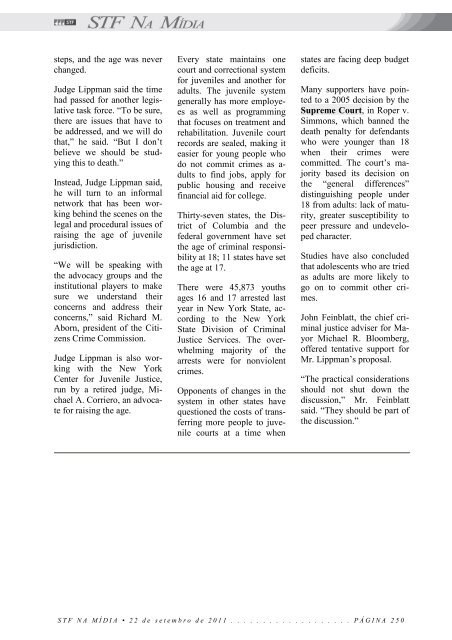STF NA MÍDIA
STF NA MÍDIA
STF NA MÍDIA
Create successful ePaper yourself
Turn your PDF publications into a flip-book with our unique Google optimized e-Paper software.
steps, and the age was never<br />
changed.<br />
Judge Lippman said the time<br />
had passed for another legislative<br />
task force. “To be sure,<br />
there are issues that have to<br />
be addressed, and we will do<br />
that,” he said. “But I don’t<br />
believe we should be studying<br />
this to death.”<br />
Instead, Judge Lippman said,<br />
he will turn to an informal<br />
network that has been working<br />
behind the scenes on the<br />
legal and procedural issues of<br />
raising the age of juvenile<br />
jurisdiction.<br />
“We will be speaking with<br />
the advocacy groups and the<br />
institutional players to make<br />
sure we understand their<br />
concerns and address their<br />
concerns,” said Richard M.<br />
Aborn, president of the Citizens<br />
Crime Commission.<br />
Judge Lippman is also working<br />
with the New York<br />
Center for Juvenile Justice,<br />
run by a retired judge, Michael<br />
A. Corriero, an advocate<br />
for raising the age.<br />
Every state maintains one<br />
court and correctional system<br />
for juveniles and another for<br />
adults. The juvenile system<br />
generally has more employees<br />
as well as programming<br />
that focuses on treatment and<br />
rehabilitation. Juvenile court<br />
records are sealed, making it<br />
easier for young people who<br />
do not commit crimes as a-<br />
dults to find jobs, apply for<br />
public housing and receive<br />
financial aid for college.<br />
Thirty-seven states, the District<br />
of Columbia and the<br />
federal government have set<br />
the age of criminal responsibility<br />
at 18; 11 states have set<br />
the age at 17.<br />
There were 45,873 youths<br />
ages 16 and 17 arrested last<br />
year in New York State, according<br />
to the New York<br />
State Division of Criminal<br />
Justice Services. The overwhelming<br />
majority of the<br />
arrests were for nonviolent<br />
crimes.<br />
Opponents of changes in the<br />
system in other states have<br />
questioned the costs of transferring<br />
more people to juvenile<br />
courts at a time when<br />
states are facing deep budget<br />
deficits.<br />
Many supporters have pointed<br />
to a 2005 decision by the<br />
Supreme Court, in Roper v.<br />
Simmons, which banned the<br />
death penalty for defendants<br />
who were younger than 18<br />
when their crimes were<br />
committed. The court’s majority<br />
based its decision on<br />
the “general differences”<br />
distinguishing people under<br />
18 from adults: lack of maturity,<br />
greater susceptibility to<br />
peer pressure and undeveloped<br />
character.<br />
Studies have also concluded<br />
that adolescents who are tried<br />
as adults are more likely to<br />
go on to commit other crimes.<br />
John Feinblatt, the chief criminal<br />
justice adviser for Mayor<br />
Michael R. Bloomberg,<br />
offered tentative support for<br />
Mr. Lippman’s proposal.<br />
“The practical considerations<br />
should not shut down the<br />
discussion,” Mr. Feinblatt<br />
said. “They should be part of<br />
the discussion.”<br />
S T F N A M Í D I A • 2 2 d e s e t e m b r o d e 2 0 1 1 . . . . . . . . . . . . . . . . . . . P Á G I N A 2 5 0
















